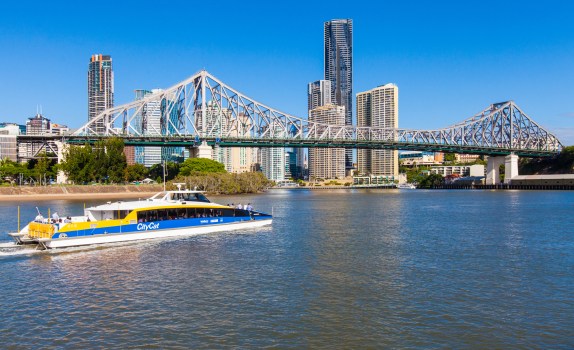While Queenslanders enjoy 50-cent fares across the state’s public transport system, Luxembourgers have it even better.
Since 2020, residents of Luxembourg – a small landlocked country in western Europe – have been able to hop on and hop off all public transport free of charge, making it the first country in the world to offer such a scheme nationwide.
Whether it be trains, buses, trams – even the funicular railway – passengers (and their pets) travel free. Only first-class or cross-border travellers are required to pay.
On a city level it was Tallinn, in Estonia, that paved the way for free public transport in Europe. Residents in the country’s capital have benefited from free bus, train and tram travel since 2013. Ten years after Tallinn, Montpellier, in southern France, made all public transport free.
From 1 January, Belgrade became the latest European city to adopt a free public transport policy. With a population of 1.7 million, the initiative makes Serbia’s capital the largest European jurisdiction to offer free fares across its entire public transport network.
Outside of Europe, Kansas, Missouri became the first major US city to offer free public transport in 2020.
Other cites around the world offer partially free public transport on specified services and routes and for certain demographics or – circling back to the top of the screen – subsidised fares.
One of the reasons cited by governments and policymakers for initiating such inducements is to ease traffic snarls.

But evidence suggests the problem isn’t always, if ever, solved. “There are generally three reasons why free public transport may not reduce road congestion,” Mark Hickman – professor of transport engineering at the University of Queensland – tells GN.
“Firstly, some of the new riders on public transport are people making new trips – not just people who are substituting public transport for car trips. Secondly, when car trips are replaced by public transport trips, new car trips appear to take their place – this is a problem of ‘induced demand’, when congestion on the road drops temporarily.”
And thirdly, in many places, the number of people using public transport is small, says Hickman – between 5-10 per cent. “This means that what appear to be big increases in public transport use are actually only diverting a small fraction of car trips.”
In the case of Luxembourg at least, EU statistics bureau Eurostat seems to prove Hickman’s point. Data released last year shows more than 75 per cent of all journeys were still being made by car.
That’s not to say there aren’t benefits to introducing free fares. “They often attract many more people to use public transport,” says Hickman. “This involves car trips switching to use public transport, but also people making new trips that they had not made before because the trips are free. In this sense, the public transport system provides better mobility.”

Queensland is a case in point. Since 50 cents fares were introduced last August, ferry trips have become increasingly popular, with government data recording ferry travel 42.8 per cent higher than the same period in 2023.
Free fares benefit public transport operators too, says Hickman. “It reduces the ‘friction’ associated with handling money – small dollar losses associated with handling cash or credit, costly machines or people to handle cash or credit purchases, etc.”
There are other benefits to be gained. Removing fares helps ease the cost-of-living pressures for people, especially those lower on the socio-economic scale.
Opening more opportunities for people to travel where they need when they need improves quality of life.
And while free fares may not entice everyone to abandon their monster truck in the driveway, they will still convert some road trips into public transport journeys. And even a marginal decrease in cars on the road can still make an impact.
But, as Hickman explains, where there are benefits negatives often exist as well. Free or subsidised fares results in the public transport operator foregoing all the money they would have gained from ticket sales.
“For example, in Queensland, it was estimated that the losses from the 50-cent fares would be $150 million over six months – a number that has borne out to date,” he says. “Governments need to cover that lost revenue and justify why that dollar amount is the best use of public funds when compared with other public investments they could make … Is this a good use of public funds, compared with other options?”
Also, Hickman tells GN that, from an equity point of view, “free for everyone” often means that some will benefit more than others.
“Those with a public transport service near their homes will benefit; those without such easy access do not get any benefit. Also, where fares are higher for longer trips – e.g., Queensland’s former zone-based fare structure – and/or for peak-hour trips – also Queensland – the people who live further out or who travel in peak times get a greater benefit.”
However, partially free schemes – such as Melbourne’s central tram zone – cause less equity concerns, says Hickman. “This is because the benefits apply fairly universally to people travelling in the zone, and a large amount of travel is oriented to and from the downtown.”
Another downside to incentivising public transport use: it may lead people to neglect alternative forms of travel, says Hickman. “This is usually not a big negative, but it is important to note that it works against encouraging walking and cycling.”
Other statistics released by the Queensland government show overall patronage across all modes of public transport is 18.3 per cent higher than the same period in 2023, and almost 5 per cent higher than pre-pandemic levels. Patronage in regional Queensland has grown by an average of about 20 per cent from the previous year across the 16 regional urban bus networks.
So the 50-cent scheme can be judged a success? “This is a values-laden judgement,” replies Hickman. “If other jurisdictions wanted to explore very low or free fares, Queensland has a lot of experience now that is transferable.”
However, through his own research in South-East Queensland, Hickman found alternative models that could be explored instead.
Eliminating fares is only one part of the equation, he says. The quality of services – such as frequency, reliability, and scale of coverage – is crucial to enticing more people out of their cars and on to public transport.
“Rather than simply cutting fares to a nominal value like 50 cents, one could reduce fares to $1 or $2 but also add more frequent bus and train services so that people can ‘turn up and go’.” More services in areas that are underserved could also be provided, says Hickman. “One could also invest in roadway or busway infrastructure to make buses faster – like the busways in Brisbane,” he adds.
It seems navigating the pros and cons of free or subsidised public transport is quite the journey…





A truly functional transport network could help reduce traffic congestion, promote sustainable travel, and improve the quality of life for everyone in Brisbane. I would gladly use public transport in Brisbane, but despite living just 10 kilometres from the CBD, my daily commute to work requires two buses and takes about two hours. Even if public transport were free, it wouldn’t be practical for me. A reliable public transport system is essential for it to be truly beneficial. My son, who works at Logan Hospital, wants to take the train, but the scheduling can often change without notice. Recently, after a late shift, he found that the train didn’t stop at his station, forcing him to walk home at 12:30 AM. Instead of being seen as a convenient option, public transport becomes a last resort, filled with uncertainty and frustration.